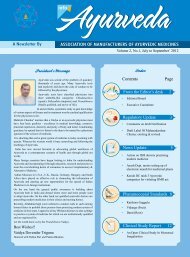Wishing our members a very auspicious and delightful Navratri ...
Wishing our members a very auspicious and delightful Navratri ...
Wishing our members a very auspicious and delightful Navratri ...
Create successful ePaper yourself
Turn your PDF publications into a flip-book with our unique Google optimized e-Paper software.
MARiCHADi GUTiKA<br />
(API Part-II, Vol. - I, Page 98)<br />
DEfiNiTioN:<br />
Marichadi Gutika is a preparation made with the ingredients in the<br />
Formulation composition given below.<br />
formulation composition:<br />
1. Maricha API Piper nigrum Fr. 12 g<br />
2. Pippalī API Piper longum Fr. 12 g<br />
3.<br />
Yavakshara (Yava<br />
API)<br />
Pharmocopial St<strong>and</strong>ards For Marichadi Gutika<br />
Hordeum vulgare<br />
Bhasma of<br />
plant<br />
4. Dadima API Punica granatum Fr. R. 24 g<br />
5. Guda API Jaggery 96 g<br />
Method of preparation:<br />
Take all ingredients of Pharmacopoeial quality.<br />
Clean, dry, powder the ingredients no. 1, 2 & 4 of the formulation<br />
composition (Prakshepa Dravya) <strong>and</strong> pass through sieve number 85 to<br />
obtain fine powder.<br />
Collect Yava kshara in the specified ratio.<br />
Take jaggery, add required amounts of water, boil to dissolve <strong>and</strong> filter<br />
through a muslin cloth.<br />
Reduce to thicker consistency by gentle boiling to prepare Guda paka.<br />
Add fine powders of Prakshepa Dravya <strong>and</strong> Yavakshara <strong>and</strong> mix<br />
thoroughly to prepare a homogeneous mass.<br />
Pass the mass through a pill making machine <strong>and</strong> cut vatis of desirable<br />
weight. Roll the vatis on a flat surface by circular motion of palm. Dry the<br />
rolled vatis in a tray-dryer at a temperature not exceeding 600.<br />
Pack it in tightly closed containers to protect from light <strong>and</strong> moisture.<br />
Description:<br />
Spherical, soft, blackish brown col<strong>our</strong>ed pills with pleasant od<strong>our</strong> <strong>and</strong><br />
sweet taste.<br />
Identification:<br />
Microscopy:<br />
Take about five pills, crush, wash with water, clear in chloral hydrate, wash<br />
in water <strong>and</strong> mount in glycerin (80 per cent) <strong>and</strong> observe the following<br />
characters:<br />
Group of isodiameric or slightly elongated stone cells with moderately<br />
thickened walls, interspersed with thin walled polygonal parenchyma cells<br />
(Maricha); groups of elongated, spindle shaped, wide lumened lignified<br />
6 g<br />
stone cells (Pippali); groups of stone cells, oval shape, striated walls with<br />
minute central lumen (Dadima).<br />
Thin layer chromatography:<br />
Extract 5 g of the powdered pills with 70 ml of ethanol in soxhlet apparatus<br />
on a Water-bath for 6 h, filter <strong>and</strong> carry out thin layer chromatography.<br />
Apply 7.5 μl of the extract on TLC plate. Develop the plate to a distance<br />
of 8 cm using ethyl acetate: n-hexane: formic acid (4: 6: 0.1) as mobile<br />
phase. After development, allow the plate to dry in air <strong>and</strong> examine under<br />
ultraviolet light (254 nm). It shows major spots at Rf 0.14, 0.20 <strong>and</strong> 0.34<br />
(fluorescent green). Spray the plate with anisaldehyde- sulphuric acid<br />
reagent <strong>and</strong> heat at 1100 for about 10 min. The plate shows major spots<br />
at Rf 0.80 (blue), 0.65 (light violet), 0.52 (violet) <strong>and</strong> 0.11 (green) under<br />
visible light.<br />
Physico-chemical parameters:<br />
Loss on drying at 110º: Not more than 10 per cent,<br />
Total ash: Not more than 6 per cent,<br />
Acid-insoluble ash: Not more than 1 per cent,<br />
Alcohol-soluble extractive: Not less than 9 per cent,<br />
Water-soluble extractive: Not less than 46 per cent,<br />
Assay:<br />
Not less than 2.83 per cent of piperine when assayed by the following<br />
method.<br />
Estimation of Piperine: Dissolve 2.5 mg of piperine in a mixture of<br />
methanol: Chloroform (1 : 1) <strong>and</strong> make up the volume to 25 ml in a<br />
volumetric flask. Apply 2, 5, 8,11, 14, 17 μl of solution on TLC plate <strong>and</strong><br />
develop the plate a distance of to 8 cm using acetone : n-hexane (3 : 7) as<br />
mobile phase. After development, dry the plate in a current of hot air <strong>and</strong><br />
scan in the TLC scanner at a wavelength of 338 nm. Note the peak area<br />
<strong>and</strong> prepare the calibration curve by plotting peak area vs concentration<br />
of piperine.<br />
Extract accurately weighed about 6 g powder of vatis in 100 ml of alcohol in<br />
a Soxhlet apparatus for 6 h. Filter the extract while hot <strong>and</strong> dry completely<br />
<strong>and</strong> weigh. Take 25 mg of extract in a volumetric flask <strong>and</strong> dissolve in a<br />
mixture of methanol: chloroform (1: 1) <strong>and</strong> make up the volume to 25 ml.<br />
Apply 3 μl of the test solutions on TLC plate. Develop, dry <strong>and</strong> scan the<br />
plate as described in the proceeding paragraph for calibration curve of<br />
piperine. Record area under the curve for a peak corresponding to piperine<br />
in the test solution. Calculate the amount of piperine in the test solution<br />
from the calibration curve of piperine.<br />
other requirements:<br />
Microbial Limits: As per prescribed limits<br />
Aflatoxins: As per prescribed limits<br />
Storage: Store in a cool place in tightly closed containers, protected from<br />
light <strong>and</strong> moisture.<br />
Therapeutic uses: Kasa (cough); Shvasa (Asthma).<br />
Dose: 3 g per day – to be dissolved slowly in the mouth.<br />
info Ayurveda, Volume 2, No. 2, Oct.-Dec.,’ 2012 12




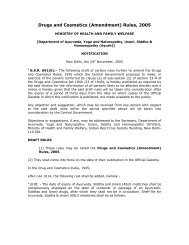
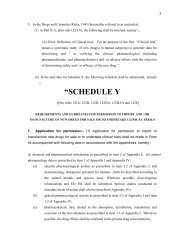
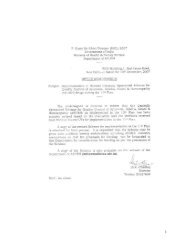

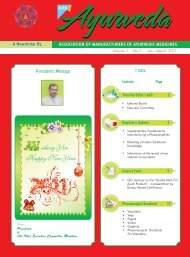

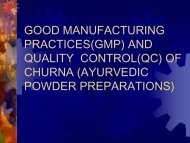
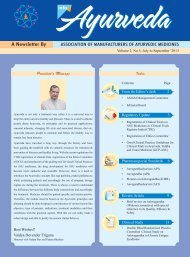
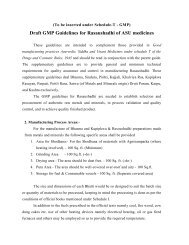
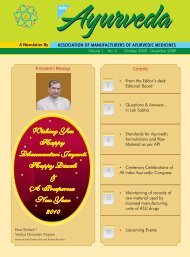
![[To be published in Gazette of India Part II Section 3, sub-section iii]](https://img.yumpu.com/28570283/1/190x245/to-be-published-in-gazette-of-india-part-ii-section-3-sub-section-iii.jpg?quality=85)
